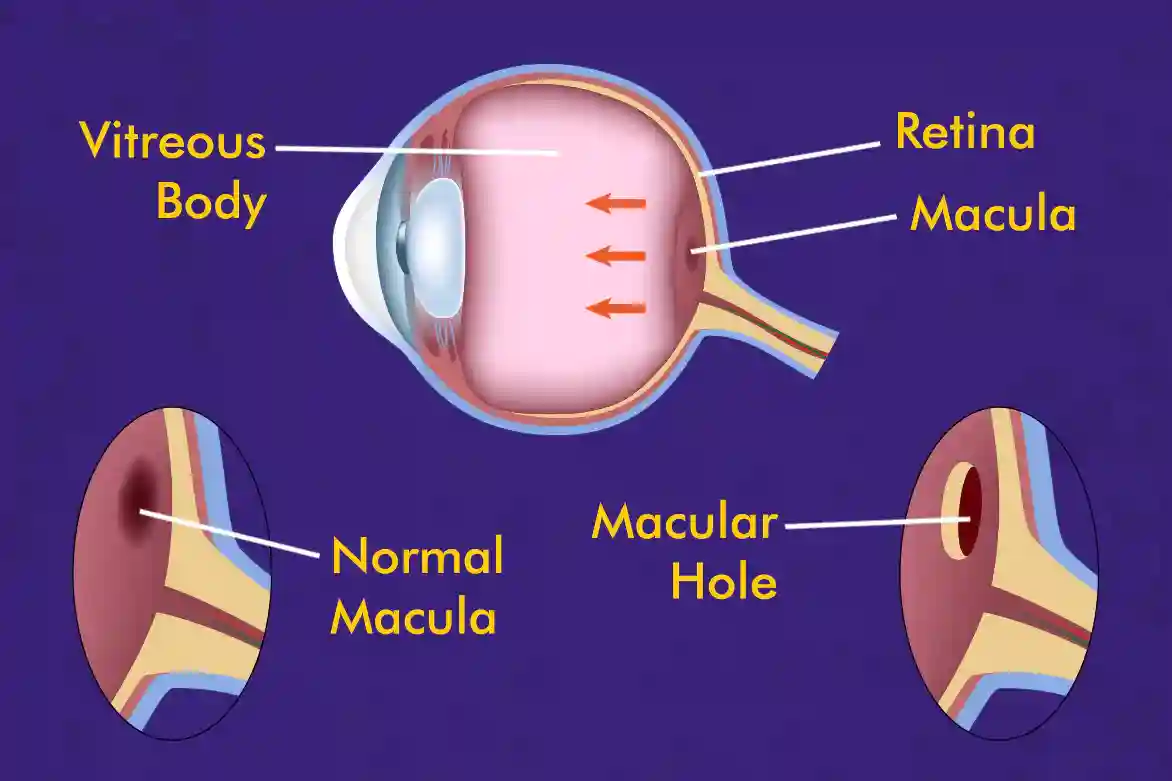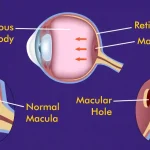Nearly 8 in every 10,000 individuals worldwide will face a perplexing and often distressing vision condition known as a macular hole. This eye condition, characterized by a small break in the macula—the central portion of the retina responsible for sharp and detailed vision—can significantly alter one’s quality of life. The macula’s pivotal role in performing everyday tasks such as reading, driving, and recognizing faces means that any damage to this area can lead to profound visual disturbances. Through a journey into the symptoms, causes, and treatments of macular holes, this blog aims to shed light on a condition that, while not widely known, has a substantial impact on the lives of those affected.
What is a macular hole?
A macular hole is a small break or opening in the macula, the central part of the retina responsible for sharp, detailed central vision. The macula’s primary role is to enable us to see fine details clearly, making it crucial for activities such as reading, driving, recognizing faces, and seeing colors vividly.
The retina is the light-sensitive layer of tissue at the back of the eye, and the macula is its most sensitive part, packed with millions of photoreceptor cells. When a macular hole in eye develops, it disrupts the normal architecture of these cells, leading to a decline in the quality of the central vision. This can manifest as blurriness, distortion, and a dark spot in the center of one’s vision. The severity of the symptoms depends on the size and location of the hole.
Types of macular holes
Macular hole types are classified based on their cause, appearance, and stage of development. Understanding these types can help in diagnosing the condition and determining the most appropriate treatment. The types of macular holes include:
- Idiopathic Macular Holes
These are the most common type of macular holes and occur without any apparent cause, although they are often associated with the natural aging process. Idiopathic macular holes typically affect people over the age of 60.
- Traumatic Macular Holes
These holes occur as a result of direct trauma to the eye or head, causing a sudden and forceful impact on the macula. Traumatic macular holes can affect individuals of any age.
- Secondary Macular Holes
These are macular holes that develop due to an underlying eye condition or disease, such as high myopia (nearsightedness), diabetic retinopathy, retinal detachment, or macular pucker. These conditions can cause changes or stress to the retinal tissue, leading to the formation of a hole.
Signs and symptoms of macular hole
The signs and symptoms of a macular hole are primarily related to the impact it has on the central vision, as the macula plays a crucial role in focusing the central vision and providing the clarity needed for detailed tasks. Some macular hole symptoms include:
- Vision becomes blurry, especially when focusing straight ahead.
- Straight lines may look bent or wavy.
- A noticeable dark spot appears in the center of vision.
- Tasks requiring sharp vision, like reading, become challenging.
- Sharpness of vision decreases, not fully correctable with lenses.
What causes a macular hole?
A macular hole is caused by the natural aging process and changes within the eye, but there are several specific factors and conditions that can lead to its development. Some of those macular hole causes are:
- Vitreous Shrinkage and Separation: As people age, the vitreous gel inside the eye can shrink and pull away from the retina, sometimes tearing the macula in the process.
- Trauma: Direct injury to the eye can lead to the formation of a macular hole.
- Diabetic Eye Disease: Conditions like diabetic retinopathy can cause swelling and damage to the retina, including the macula.
- High Myopia: Severe nearsightedness can stretch the retina, making it more susceptible to holes.
- Macular Pucker: Scar tissue on the macula can contract and cause a hole.
- Retinal Detachment: Areas of the retina pulling away from the back of the eye can result in a macular hole in eye.
- Age-Related Changes: Natural aging processes can weaken the retinal tissue, leading to holes.
Macular hole Vs retinal hole: what’s the difference?
While both macular holes and retinal holes involve openings in the retina, the key distinction lies in their location and the impact on vision they can have. A macular hole occurs specifically in the macula, the central part of the retina that is essential for high-resolution vision necessary for detailed tasks such as reading and recognizing faces. Consequently, a macular hole directly affects central vision, leading to significant difficulties in performing activities that require seeing fine details.
On the other hand, retinal holes can form anywhere in the retina and may not always impact central vision unless they occur in the macula. The causes and potential symptoms of retinal holes overlap, such as vision distortion and the presence of dark spots in one’s vision, but the severity and specific visual impairments experienced depend largely on the hole’s location. Retinal holes are particularly noted for their prevalence among individuals over the age of 55 years, highlighting an age-related risk factor, whereas retinal holes causes can be influenced by a broader range of factors, including eye injuries and other retinal conditions. Treatment options to resolve the issue of retinal holes may include procedures like retinal hole laser treatment or cryotherapy, which aim to seal the retinal holes and prevent further visual deterioration.
How to diagnose a macular hole?
Diagnosing a macular hole typically involves a comprehensive eye examination by an eye care professional. During the exam, the doctor may use optical coherence tomography (OCT), a non-invasive imaging test that provides high-resolution cross-sectional images of the retina, enabling the precise visualization of the macula’s structure. This technique can help in identifying the presence, size, and stage of a macular hole. Additionally, a procedure called a fundus examination may be performed, where the eye is dilated with drops, and a special lens is used to examine the back of the eye, including the retina and macula. These diagnostic tools are critical for confirming the diagnosis of a macular hole and for planning the appropriate treatment strategy.
Treatment options to resolve the issue of macular hole
The primary treatment for a macular (retinal) hole is a macular hole surgery, also known as vitrectomy. During a vitrectomy, the surgeon removes the vitreous gel that is pulling on the macula and replaces it with a bubble of gas or air. This bubble acts as a temporary internal bandage that holds the edges of the macular hole in place as it heals. In macular hole treatment, patients typically need to maintain a specific head positioning, often face-down, for several days to a week after surgery to ensure the bubble effectively presses against the hole.
Ways to prevent the development of macular holes
Preventing the development of macular holes involves maintaining overall eye health through regular eye exams, especially as you age or if you have risk factors like high myopia or diabetes. Protecting your eyes from injury by wearing protective eyewear during activities that could lead to trauma can also help. Managing underlying health conditions that could affect the eyes, such as diabetes or high blood pressure, is crucial.
Risks and complications of Macular Hole if left untreated
If a macular hole in eye is left untreated, several risks and complications can arise, impacting vision and overall quality of life:
- Worsening vision loss.
- Permanent central vision loss.
- Increased visual distortion.
- Challenges in daily activities (e.g., reading, driving).
- Potential for amblyopia (“lazy eye“).
Macular holes are a significant cause of vision impairment, particularly among the elderly. Recognizing the symptoms early and seeking prompt medical attention can lead to effective treatment and improved outcomes. Advances in surgical techniques continue to enhance the success rates of treating macular holes, offering hope to those affected by this condition. Maintaining regular eye exams, especially as one ages or if experiencing any symptoms of visual disturbance, is key to detecting and treating macular holes before they lead to severe vision loss.
FAQs
Can macular holes occur in both eyes simultaneously?
Yes, but it’s rare for macular holes to develop in both eyes at the same time.
Are macular holes age-related?
Yes, macular holes are often age-related, commonly occurring in people over the age of 60.
Know in detail about Age-Related Macular Degeneration
Who is at risk for a macular hole?
Those at higher risk include individuals over 60, women, people with high myopia, and those with a history of eye trauma or retinal detachment.
What causes a macular hole?
Causes include vitreous shrinkage and separation from the retina, eye injuries, and conditions that affect the retina, like high myopia or diabetic retinopathy.
Can genetics influence the likelihood of developing macular holes?
There’s limited evidence to suggest a genetic predisposition to macular holes.





